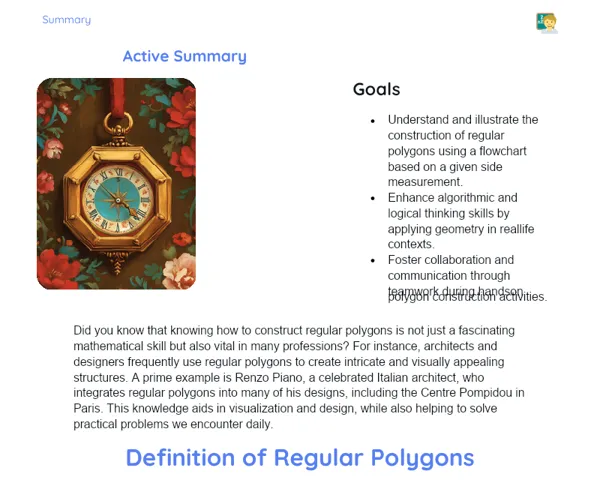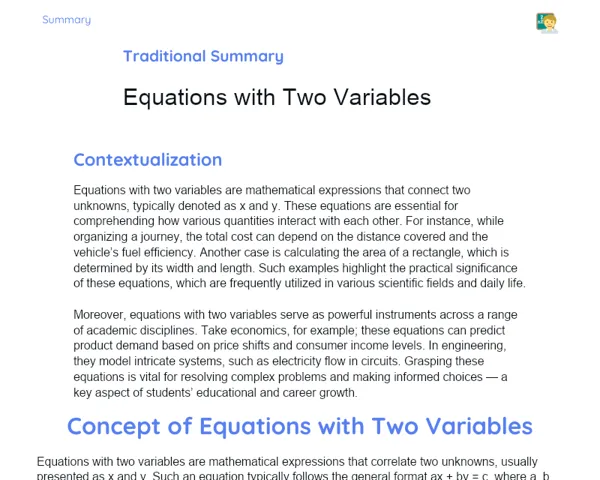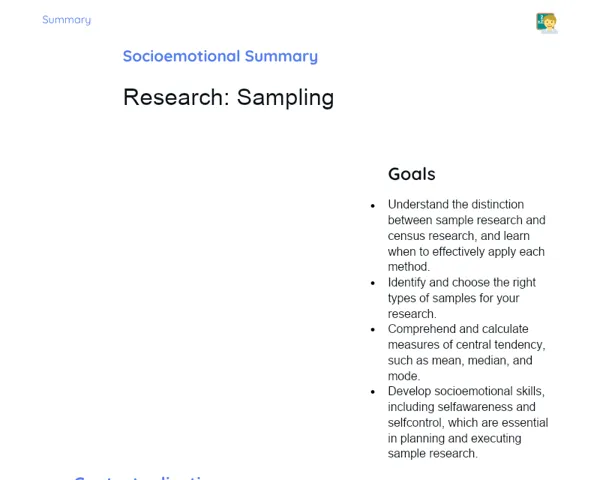Summary Tradisional | Hexagon Area
Contextualization
A hexagon is a six-sided geometric figure. When every side and angle is equal, we call it a regular hexagon. This particular shape has some unique properties that make calculating its area much simpler—a useful skill not only in textbooks but also in everyday applications.
In this lesson, we will look at a formula that helps compute the area of a regular hexagon quickly. This understanding comes in handy in many practical situations, whether it’s in designing an aesthetically pleasing floor pattern in a building or examining the natural design of bee hives, which optimizes space for honey storage.
To Remember!
Concept of Regular Hexagon
A regular hexagon is a shape with six equal sides and six equal internal angles. Each angle in such a hexagon is 120 degrees, and having uniform sides and angles gives it a pleasing symmetry. This makes the figure not just interesting but also quite practical in fields like architecture and design.
Moreover, a regular hexagon can be broken down into six equilateral triangles. Since the area of an equilateral triangle is well understood, this subdivision helps in calculating the total area of the hexagon more easily.
A sound grasp of what a regular hexagon is forms the basis of applying geometric formulas correctly. Its unique properties allow for simpler computations and can be particularly useful in optimization challenges.
-
A regular hexagon has six equal sides and six equal angles.
-
Each internal angle measures 120 degrees.
-
It can be divided into six equilateral triangles.
Area Formula for Regular Hexagon
The area of a regular hexagon can be determined by first calculating the area of one of the equilateral triangles into which the hexagon can be divided, and then multiplying it by six.
The formula to compute the area is given by A = (3√3/2) * L², where ‘L’ represents the length of one side of the hexagon. This comes from knowing that each equilateral triangle has an area of (√3/4) * L².
This formula is particularly useful in real-life scenarios such as planning out a hexagonal flooring design or even in understanding natural structures. All you need is the measurement of one side, and you can compute the area of the hexagon with relative ease.
-
Area formula: A = (3√3/2) * L².
-
It is based on the area of equilateral triangles.
-
Simplifies the calculation in practical applications.
Practical Applications of Hexagon Area Calculation
Knowing how to calculate the area of a regular hexagon has many useful applications. For instance, in architecture, hexagons are often used in the design of floors and walls because they cover space efficiently and add an aesthetic touch. Their shape ensures there are minimal gaps, making the best use of materials.
In the world of biology, the hexagonal design of a bee hive is a natural example of spatial efficiency—it maximizes storage while consuming minimum wax.
Beyond these, measuring hexagonal areas is also important in various optimization problems and other areas that require covering surfaces with regular shapes. Thus, understanding the geometry of hexagons can be a versatile addition to one’s toolkit.
-
Hexagons are common in designing floors and walls in architecture.
-
Bee hives use hexagonal patterns to optimise space and material.
-
Useful in solving optimization problems and managing surface coverage.
Problem Solving with Hexagons
When solving problems that involve hexagons, it is important to apply the area formula correctly and to understand the underlying geometric properties. For instance, if you are asked to calculate the area of a regular hexagon with a side of 8 cm, you simply substitute 8 into the formula A = (3√3/2) * L². The steps are straightforward and logical.
Another common approach is to find the area by dividing the hexagon into six equilateral triangles and then adding their areas. This method can sometimes make it easier to understand the problem.
Such problems are not only relevant in academic settings but also in everyday tasks, like figuring out the tile requirements for a room with a hexagonal design or planning material usage in construction. Working through these problems helps enhance both mathematical insight and logical reasoning skills.
-
Practical application of the area formula.
-
Using equilateral triangles simplifies the area calculation.
-
Enhances mathematical understanding and reasoning.
Key Terms
-
Regular Hexagon: A six-sided figure with all sides and angles equal.
-
Equilateral Triangle: A triangle with three equal sides and angles.
-
Area Formula: A method to calculate the area of a geometric shape.
-
Spatial Efficiency: Making the most effective use of space.
-
Practical Application: Using theoretical knowledge in real-life situations.
Important Conclusions
In this lesson, we explored the regular hexagon and its inherent properties that simplify area calculations. We looked at the specific formula A = (3√3/2) * L² and understood how this connects back to the area of equilateral triangles. We also discussed the practical applications of this knowledge—from the design of bee hives to innovative floor plans in architecture.
This exploration into the geometry of hexagons is not just academic; it offers practical insights into solving everyday problems involving spatial and material optimization. Practicing these calculations is a great way for students to strengthen their mathematical skills and logical thinking, which are vital in both professional fields and daily life.
I encourage students and educators alike to keep exploring these concepts, as the world of geometry is full of fascinating connections. Understanding how mathematics shapes our environment only deepens our appreciation of the subject and its wide-ranging applications.
Study Tips
-
Revisit the formula for the area of a regular hexagon and practice by plugging in different side lengths to improve your understanding.
-
Look at real-life problems, such as designing a hexagonal floor or understanding bee hives, to see how these concepts are applied.
-
Dive deeper into the properties of hexagons and other geometric figures to broaden your knowledge of the subject.



